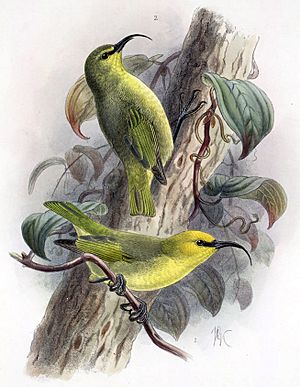Maui nukupuʻu facts for kids
Quick facts for kids Maui nukupuʻu |
|
|---|---|
 |
|
| Painting by Keulemans | |
| Conservation status | |
| Scientific classification | |
| Genus: |
Hemignathus
|
| Species: |
affinis
|
| Synonyms | |
|
Hemignathus lucidus affinis |
|
The Maui nukupuʻu (Hemignathus affinis) is a special type of Hawaiian honeycreeper bird. It lives only on the island of Maui in the Hawaiian Islands. This small bird is about five inches long.
It makes its home in the eastern part of Maui. It prefers high-up, wet forests where ʻōhiʻa lehua (Metrosideros polymorpha) and koa (Acacia koa) trees grow. These trees are important because they attract insects, which are the main food for the Maui nukupuʻu.
About the Maui Nukupuʻu
Male Maui nukupuʻu birds have green backs and heads. Their faces, necks, bellies, and undersides are yellow. Female birds are completely olive green and are usually quieter than the males. Young birds are gray and green.
This bird has a long, curved bill, about an inch long. This bill is very useful! The bird uses it to peck out insects hidden in the bark of trees.
Where the Maui Nukupuʻu Lives
In the past, the Maui nukupuʻu lived in many places, even in West Maui and at lower elevations. More recently, it was found in the Hanawi Area Reserve. Here, it lived at heights from 3,000 to 4,500 feet above sea level.
Population and Threats
The Maui nukupuʻu was common in the early 1900s. But by 1963, people thought it had disappeared completely. This is called being extinct.
However, in 1980, the bird was found again! This was a happy rediscovery. At that time, experts thought there were only about 28 birds left. By 1994, the number dropped even more, with only one male bird seen. It was never seen again after that.
There have been a few reports of this bird even in 2007. But it seems these sightings were actually of a different common bird called the ʻamakihi.
Any Maui nukupuʻu birds that might still be alive face many dangers. Their forest homes are shrinking or getting damaged. This happens because of things like introduced animals with hooves, and a bird disease spread by introduced mosquitoes.
See also
 In Spanish: Nukupuu de Maui para niños
In Spanish: Nukupuu de Maui para niños


